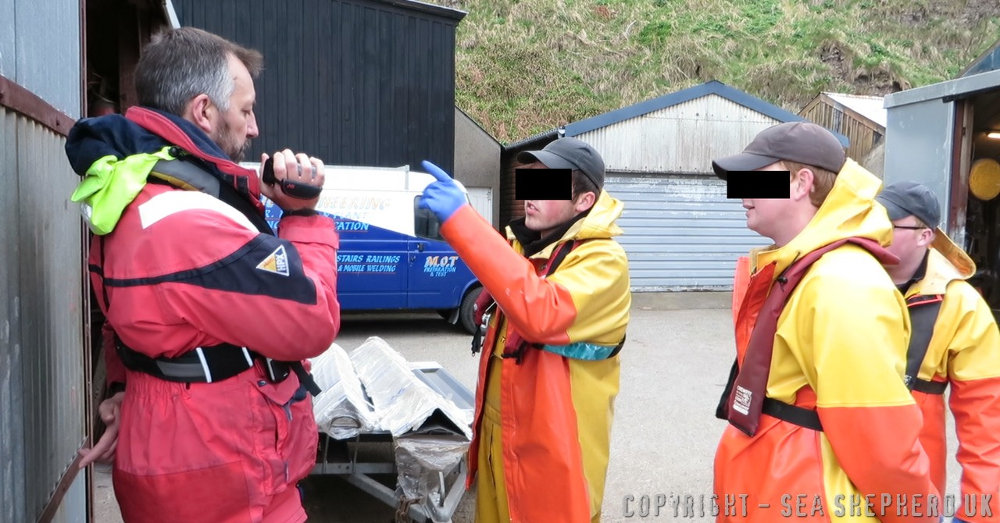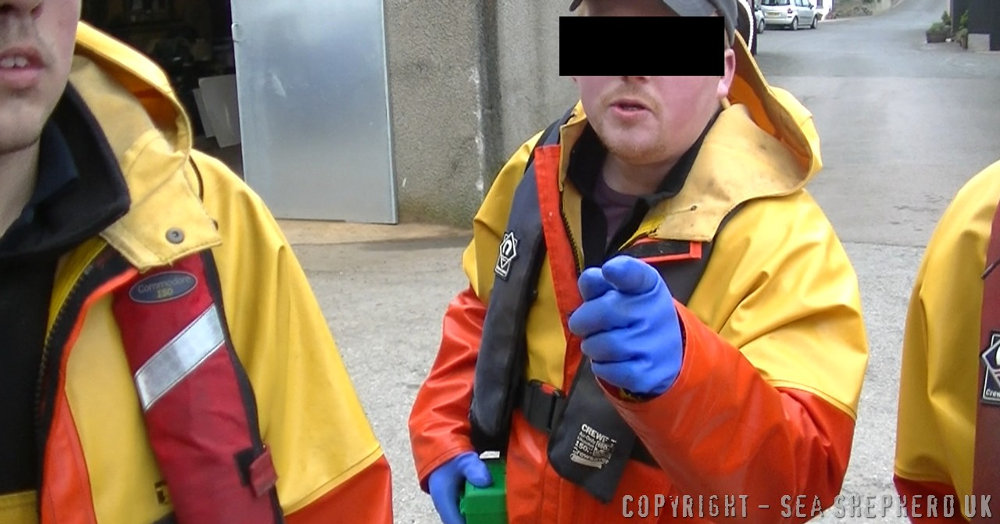Marine Life & Conservation
Violent Seal Killers Threaten Sea Shepherd UK Crew – Caught on Camera

Here’s the latest press release from Sea Shepherd:
As predicted by Sea Shepherd on Good Friday, the killing team of the Scottish Wild Salmon Company escalated tensions in the Scottish seal killing grounds with an unprecedented attack on a member of Sea Shepherd UK’s campaign crew.
As residents of Gardenstown were preparing for breakfast on Easter Monday, Sea Shepherd crewmembers were already being threatened with violence by the Scottish Wild Salmon Company’s seal killers.
In a dramatic 8 a.m. confrontation which took place away from the Harbour in the town’s New Ground, three employees of the Scottish Wild Salmon Company, one carrying a rifle, cornered just one of our crewmembers, leaving him fearful of extreme violence.
The crewmember had the presence of mind to keep his camera running throughout, and the situation was saved when other members of the Sea Shepherd campaign crew arrived with their own cameras. Realizing that any further illegal acts on their part were being recorded, the thugs backed away and returned to their command base.
Sea Shepherd UK has now reported the situation and shown video footage to the Scottish Police. Sea Shepherd UK is confident that charges can now be brought against the ringleader of the Scottish Wild Salmon Company’s out-of-control thugs.
Given the escalating situation, Sea Shepherd UK has now asked the Hunt Saboteurs Association to reactivate their undercover teams as well as introduce new covert operatives to the area. Other Sea Shepherd volunteers and specialist intervention teams are also now heading to Banffshire in order to defend Scottish seals from these violent people.
The Scottish government issues companies such as the Scottish Wild Salmon Company with licenses to shoot seals, which they claim threaten fish stocks. However the legislation requires that seals may only ever be shot as a last resort after all other methods of control have been applied. The actions of these companies themselves are drawing seals to the salmon. Seals in this area do not normally eat salmon, but when salmon netting companies trap wild fish in large numbers, it is only natural that the captured fish attract seals. As we’ve seen with the sea lions on the Columbia River on the Oregon/Washington border here in the U.S., these animals are being targeted for the simple “crime” of eating fish. Moreover, the wild salmon that are heading up the coast are being caught by fishermen before they have a chance to spawn, so the fishing itself is killing this particular fishery and is therefore completely unsustainable.
The non-lethal solution is to deploy Acoustic Deterrent Devices (ADDs), which the Scottish Wild Salmon Company does have available to them. Unfortunately, lethal bullets are cheaper than the non-lethal alternative, and so, without effective policing by Marine Scotland (the agency responsible for the seal killing licenses), it is left to Sea Shepherd to once again uphold national and international laws which governments neither can’t nor won’t enforce.
For more information, visit www.seashepherd.org.uk.
Blogs
Invitation from The Ocean Cleanup for San Francisco port call

6 years ago, The Ocean Cleanup set sail for the Great Pacific Garbage Patch with one goal: to develop the technology to be able to relegate the patch to the history books. On 6 September 2024, The Ocean Cleanup fleet returns to San Francisco bringing with it System 03 to announce the next phase of the cleanup of the Great Pacific Garbage Patch and to offer you a chance to view our cleanup system up-close and personal.
We look forward to seeing you there.
To confirm your presence, please RSVP to press@theoceancleanup.com
PROGRAM
Join The Ocean Cleanup as our two iconic ships and the extraction System 03 return to San Francisco, 6 years and over 100 extractions after we set sail, to create and validate the technology needed to rid the oceans of plastic.
Our founder and CEO, Boyan Slat, will announce the next steps for the cleanup of the Great Pacific Garbage Patch. Giving you a chance to view our cleanup system and the plastic extracted.
Hear important news on what’s next in the mission of The Ocean Cleanup as it seeks to make its mission of ridding the world’s oceans of plastic an achievable and realistic goal.
Interviews and vessel tours are available on request.
PRACTICALITIES
Date: September 6, 2024
Press conference: 12 pm (noon)
Location: The Exploratorium (Google Maps)
Pier 15 (Embarcadero at Green Street), San Francisco, CA
Parking: Visit The Exploratorium’s website for details.
RSVP: press@theoceancleanup.com
Video & photo material from several viewing spots around the bay
We look forward to seeing you there!
ABOUT THE OCEAN CLEANUP
The Ocean Cleanup is an international non-profit that develops and scales technologies to rid the world’s oceans of plastic. They aim to achieve this goal through a dual strategy: intercepting in rivers to stop the flow and cleaning up what has already accumulated in the ocean. For the latter, The Ocean Cleanup develops and deploys large-scale systems to efficiently concentrate the plastic for periodic removal. This plastic is tracked and traced to certify claims of origin when recycling it into new products. To curb the tide via rivers, The Ocean Cleanup has developed Interceptor™ Solutions to halt and extract riverine plastic before it reaches the ocean. As of June 2024, the non-profit has collected over 12 million kilograms (26.4 million pounds) of plastic from aquatic ecosystems around the world. Founded in 2013 by Boyan Slat, The Ocean Cleanup now employs a broadly multi-disciplined team of approximately 140. The foundation is headquartered in Rotterdam, the Netherlands, and opened its first regional office in Kuala Lumpur, Malaysia, in 2023.
Find out more about The Ocean Cleanup at www.theoceancleanup.com.
Marine Life & Conservation
SHARK MONTH ARRIVES AT ROYAL WILLIAM YARD, PLYMOUTH

A shark has been spotted approaching Royal William Yard in Plymouth, much to the surprise of swimmers, paddleboarders and onlookers.
With its distinctive dorsal fin cutting through the water, the sizeable shark swam along the coastline, before turning to head inland towards Firestone Arch at Royal William Yard. The appearance drew a crowd, who were captivated for more than an hour by the unusual sight – and it was all caught on video.
The shark is one of many expected sightings at Royal William Yard over the coming weeks… because today marks the start of Shark Month!
In reality, the ‘shark’ spotted along the Plymouth shoreline was actually a custom-made model, created by the team at Royal William Yard and sailed underwater by Caroline Robertson‑Brown from the Shark Trust, who donned scuba diving gear for the occasion.
The stunt took place to launch Shark Month in style and draw attention to the work of the leading international conservation charity, which is based in Britain’s Ocean City. Spectators were reassured that the water was safe and many entered into the spirit of the performance, swimming or sailing alongside the shark.
Shark Month will take place across Royal William Yard throughout July and will feature an extravaganza of art, entertainment and advocacy for everyone to enjoy. The packed programme of events starts with an art exhibition and ends with a trip on paddleboards with shark experts – with everything from a shark quiz to a Jaws screening in between.
Paul Cox, CEO of the Shark Trust, said: “There are often assumptions and misconceptions when it comes to sharks. This was certainly the case with the shark spotted at Royal William Yard! While the British coastline is home to many species of shark, this was not one of them. However, we’re thrilled it caught people’s attention, because seeing a shark is a special and memorable moment. That is precisely why we want to celebrate these incredible creatures, highlight the need for conservation, and ask for help to safeguard their future.”
For more information about Shark Month at Royal William Yard, visit the Shark Trust Website.
Images and video: Jay Stone
-

 Blogs2 months ago
Blogs2 months agoDiving With… Nico, Ocean Earth Travels, Indonesia
-

 News1 month ago
News1 month agoMurex Bangka Announce New Oceanfront Cottages & Beachfront Dining
-

 Blogs2 months ago
Blogs2 months agoA new idea in freediving from RAID
-

 Marine Life & Conservation1 month ago
Marine Life & Conservation1 month agoIceland issue millionaire whale hunter a licence to murder 128 vulnerable fin whales
-

 Marine Life & Conservation2 months ago
Marine Life & Conservation2 months agoThe Shark Trust Great Shark Snapshot is back
-

 News3 months ago
News3 months agoCharting New Waters; NovoScuba Goes Global with the Launch of their Revolutionary Dive Training Agency!
-

 Gear News1 month ago
Gear News1 month agoNew Suunto Ocean – a dive computer and GPS sports watch in one for adventures below and above the surface
-

 Marine Life & Conservation Blogs2 months ago
Marine Life & Conservation Blogs2 months agoBook Review: Plankton


















